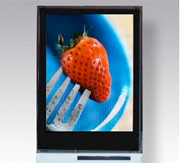Toshiba Matsushita Display Technology and Idemitsu have jointly developed a small-molecule organic electroluminescent (EL) display panel for mobile equipment, with one tenth the power consumption, and a lifetime of up to 30 times longer, as compared to existing TMD models.
The joint development involved the TFT substrate design technology and element design technology of TMD; development of materials by Idemitsu, including RGB light-emitting materials and peripheral materials which offer high-efficiency and low-power consumption; and joint evaluation of the optimum combination of materials by both parties. As a result, TMD and Idemitsu succeeded in achieving the world's highest level of performance for an organic EL display screen of 2.2-inch QVGA (240x320) format suitable for mobile equipment applications, with power consumption of 100 mW (based on typical movie screen images, defined by 30% brightness of a full-white screen) and luminosity half-life of 60K hours (based on a full-white screen at 200 cd/m2).
Since the fine organic EL layer formed on the glass substrate is a light-emitting device, an organic EL display can achieve high-contrast and high-definition images. These displays can also realize high speed motion on the screen without blur and with a wide viewing angle. Furthermore, the organic EL displays feature resource-saving features, such as lower power consumption, and require less material to build the display, since no backlight peripheral components are necessary, contributing to the display's thinness.
TMD is now focused on the technological development of organic EL displays with these power-saving and lifetime-extending high-performance features, based on TMD’s proprietary low-temperature poly-silicon technology. In the past, TMD has acquired experience in the development of small-molecule organic EL displays suitable for cellular phones and small-sized mobile devices, and TMD has also acquired experience in developing polymer organic EL displays that are appropriate for larger screens. In 2005 TMD provided low-volume production of 3.5-inch organic EL panels which were well accepted in the test market. Since January 2005, TMD has been working with Idemitsu on the development of materials for small-molecule organic EL display panels, evaluation of their compatibility with TFT circuitry, optimization of device design, and other joint development programs.
Idemitsu has been continuosly involved in the development of advanced light-emitting materials since 1997, at which time the company succeeded in developing a blue light-emitting material boasting the world's highest brightness based on the application of the company's proprietary molecular design and organic synthesis technologies. The company has also been actively working to develop technology for material combination to maximize the performance of organic EL materials and structural technology for organic EL elements, in addition to the development of advanced materials.

